Forget the hype and go outside to enjoy the real thing — a relatively bright comet you can see in binoculars from a dark sky.
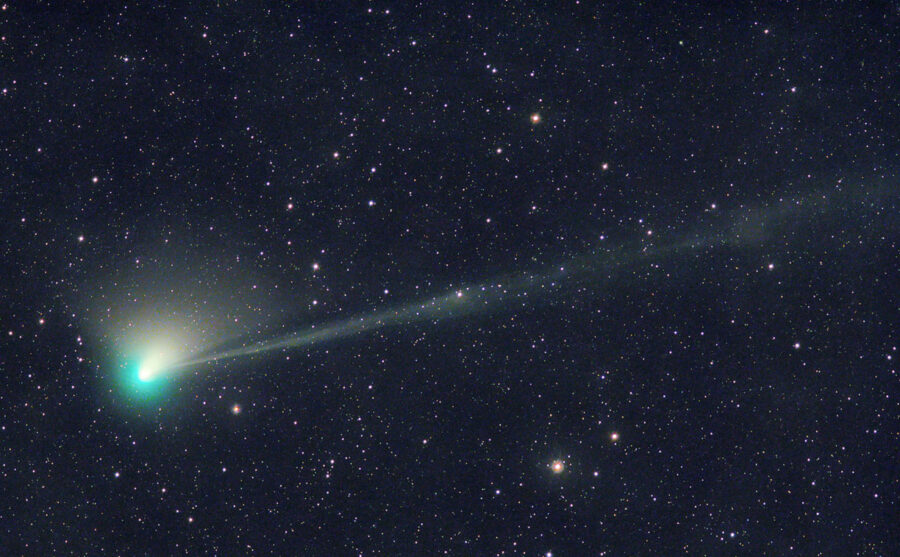
Michael Jaeger
Dazzling green comet! First appearance in 50,000 years! Watch it streak across the sky! Based on recent headlines you’d think Comet ZTF (C/2022 E3) was the greatest astronomical event of modern times. While it’s not all that, this Oort Cloud refugee is already visible in binoculars and a pretty sight in modest telescopes. Observers with dark, moonless skies may even spot the comet with the naked eye (dimly) as it sails between the the Big and Little Dippers later this month. Thanks to clouds and moonlight I last saw it in late December at 8th magnitude in Corona Borealis.
Current visual magnitude estimates put Comet ZTF at between magnitude 6.5 and 7.0. Expect it to peak around magnitude 5.5 at the end of January into early February. Not to throw shade, but Jose Pablo Navarro, amateur astronomer and administrator of the Facebook group Comet Asteroid Meteor Watch, examined 2,509 visual and CCD observations of the comet from the Minor Planet Center database. His analysis indicates a recent slowdown in the comet's rate of brightening, with a peak brightness closer to 6.0 magnitude. Time will tell.

Michael Jaeger
Photographs show a striking blue-green coma, a feature often seen in comets that journey into the inner solar system. Solar ultraviolet (UV) light breaks down large organic molecules boiling off the nucleus into simpler compounds, including green-glowing diatomic carbon (C2). Within a couple of days, that same energetic light destroys the molecule before it has time to leave the coma, preventing it from traveling into the comet’s tail and tinging it green. Sometimes the delightful Caribbean hue is subtly visible in binoculars, but normally a 6-inch or larger telescope is required.
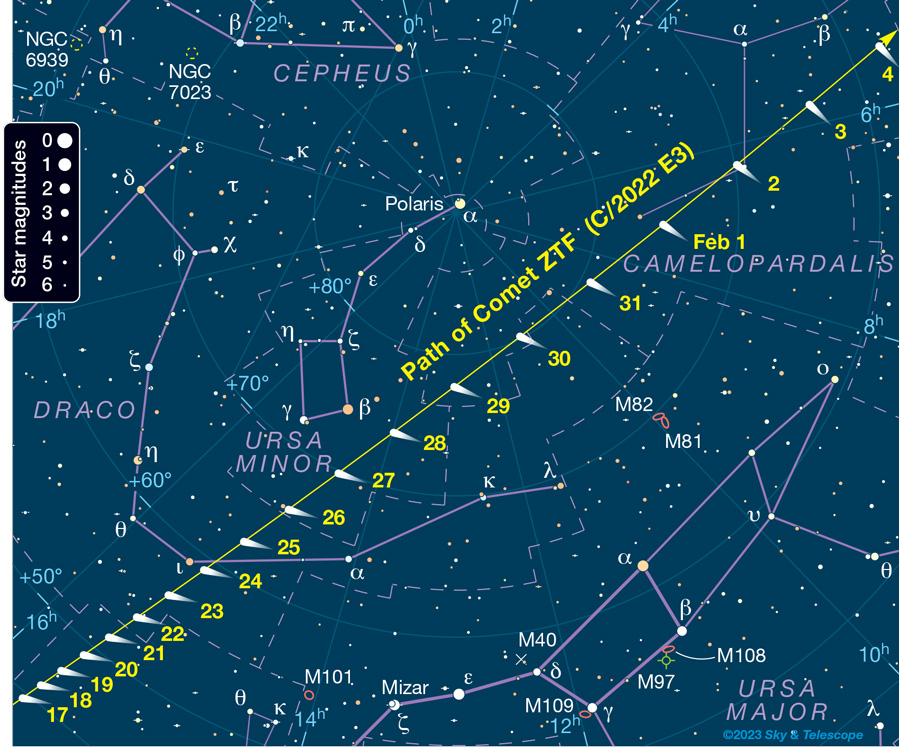
Sky & Telescope
Comet ZTF (C/2022 E3) is named for the Zwicky Transient Facility, a public-private partnership based at Caltech’s Palomar Observatory in California. Every two nights, a wide-field CCD camera attached to the 48-inch Samuel Oschin Telescope scans the entire northern sky in search of anything that blinks or moves. Among its quarry are near-Earth asteroids, thousands of supernovae (more than 6,600 classified to date), and numerous comets.
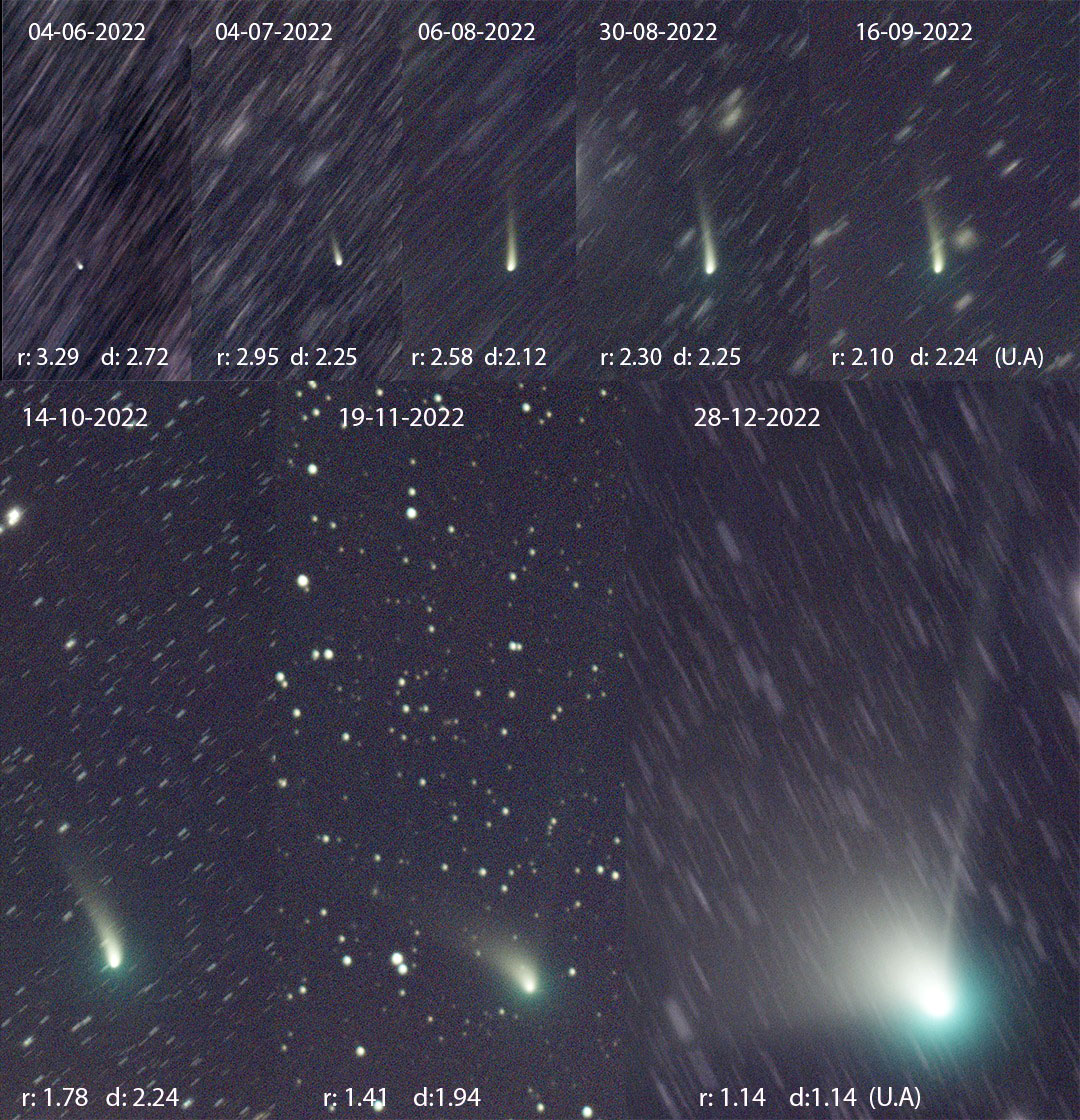
Dídac Mesa Romeu
C/2022 E3 was discovered on March 2, 2022, and initially reported as an asteroid candidate. One night later, Japanese observer Hirohisa Sato’s photographs of the object revealed a small coma, changing its status to a comet. More observations by additional observers confirmed Sato’s report. At the time, the 17th-magnitude speck was nearly 5 astronomical units from Earth, nearly identical to Jupiter’s average distance from the Sun.
On January 16–17, you’ll find our fuzzy friend in northeastern Boötes headed northwest at around 1.5° per day. Closest approach to Earth occurs on February 1st, when the comet will whiz past at 42 million kilometers (26 million miles). Perihelion (closest approach to the Sun) occurred on January 12th at 166 million kilometers (103 million miles). While its inbound period was 53,000 years, due to perturbations by the planets ZTF is now headed out of the solar system altogether. Perhaps one day the peripatetic puffball will become another star system's first interstellar comet.
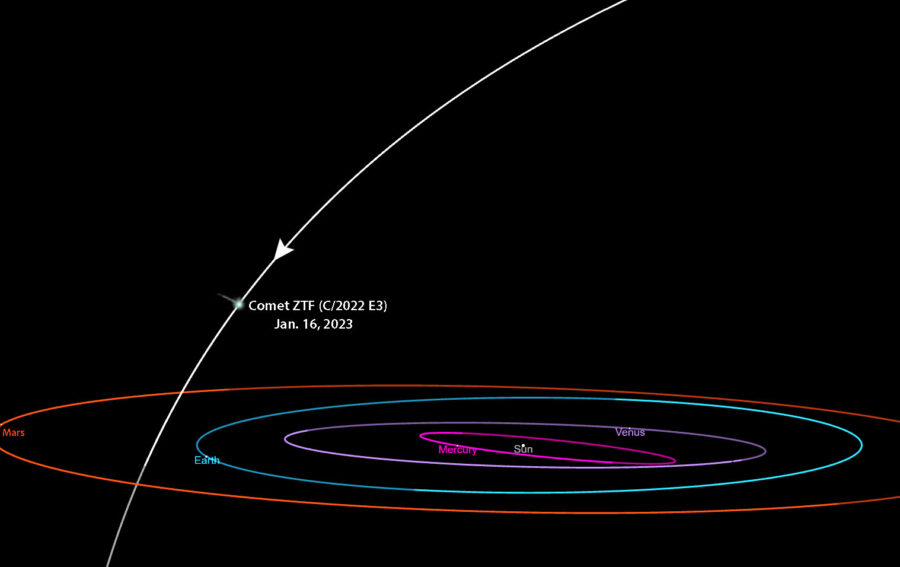
NASA HORIZONS
As Comet ZTF E3 closes in on our planet in the coming weeks, its apparent motion across the northern sky and altitude increase quickly. The comet becomes a circumpolar object for the northern states and Canada around January 17th and for the rest of the continental U.S. on January 25th. Come month’s end, Comet ZTF will be trucking along at the rate of 6.5° a day! That’s better than ¼° per hour, making its motion relative to the background stars obvious through a telescope after just a few minutes. Even 10× binoculars will reveal movement in an hour or two.
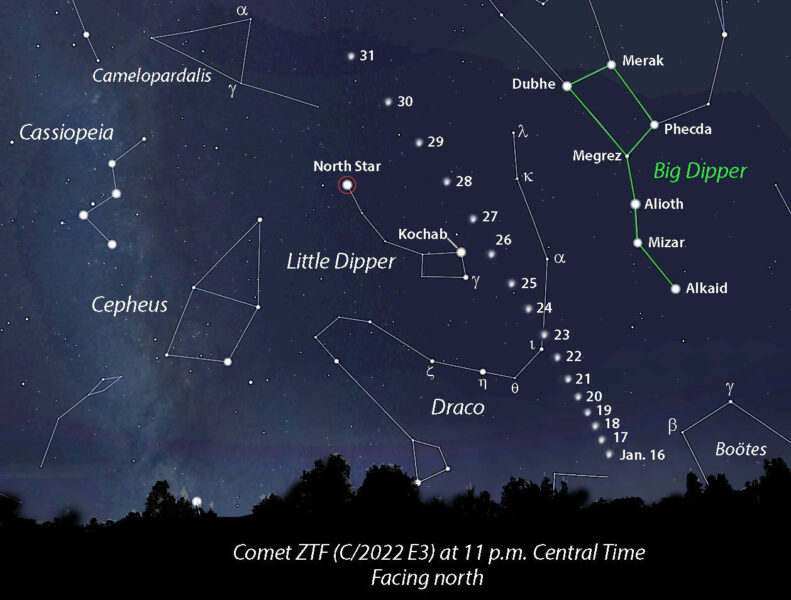
Stellarium with additions by Bob King
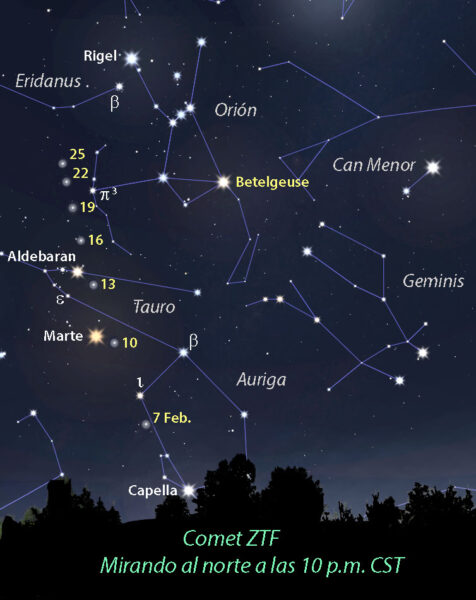
Stellarium with additions by Bob King
From latitude 40° north the comet stands 10° high in the northeastern sky on the night of January 16–17 at local midnight. That improves to 21° five nights later on January 21st. During much of January, observers in the northern U.S. will see the comet higher up earlier in the night compared to those in the southern part of the country, where the best views will be after 2 a.m. local time. Viewing becomes more equitable across the U.S. by late January when the object will be circumpolar for everyone. The table below addresses Comet ZTF’s continually changing circumstances as it climbs higher and higher while playing tag with the Moon.
| Dates | Comet 25° or higher, minimal Moon | Moon phase |
| Jan. 16–24 | Midnight till dawn | Waning crescent to waxing crescent |
| Jan. 24 | 11 p.m. till dawn | Waxing crescent |
| Jan. 25 | 10 p.m. till dawn | " " |
| Jan. 26 | 9 p.m. till dawn | " " |
| Jan. 27–28 | 7 p.m. till dawn | " " |
| Jan. 29–Feb. 2 | Early morning hours after moonset | First quarter to waxing gibbous |
| Feb. 3–5 | Moon interferes all night | Waxing gibbous to full Moon |
| Feb. 6–22 | Moonless window opens again — evening hours | Waning gibbous to waxing crescent |
First-quarter phase occurs on January 28th, when the Moon will set around 12:30 a.m. (on January 29th). A half-moon isn’t much of a comet-killer especially when it shines at the opposite end of the sky. However, by month’s end, the waxing gibbous Moon in Taurus and then Gemini will diminish the comet’s appearance if you plan to observe it before midnight. Fortunately, the Moon sets in the wee hours through February 2nd, leaving dark-sky windows to observe and photograph the bearded visitor at its closest and brightest.
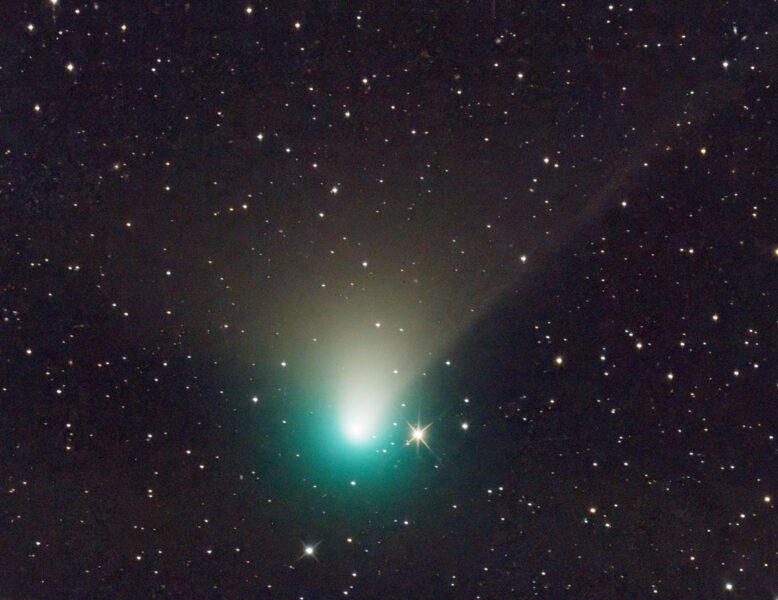
Juanjo Gonzalez
By early February the comet is firmly ensconced in the evening sky. It slides about 1.5° southwest of Capella on the evening of February 5th, the night of full Moon. The following evening it brushes Zeta (ζ) Aurigae in the Kids asterism. While the compact nuclear region will miss the star by ~10′, the fluffy coma may temporarily engulf it. Mars gets a visit on the night of February 10–11 when the comet cruises about 1.5° northeast of the planet for observers in the eastern half of the Americas. West Coast viewers will see them just 1° apart. The two bodies, one golden-orange, the other green and turquoise, should make a fine color contrast in time-exposure photos. Come Valentine’s Day (February 14th), Comet ZTF will have faded to about magnitude 7.0 and glow in a moonless sky around 1.5° east of Aldebaran in Taurus.
Then it’s back to the Oort Cloud for this interloper. Like most comets from this distant realm, its C/2022 E3's first journey to the inner solar system, and we'll likely never see it again. So don’t forget to wave “goodbye!” You can stay abreast of the comet’s magnitude, coma diameter, and more at the Comet Observation Database (COBS). Click on the Recent Observations link, then search for C/2022 E3. Another excellent source is Weekly Information about Bright Comets. Happy hunting!
 49
49









Comments
Tom Hoffelder
January 16, 2023 at 3:43 pm
Finally, the real story! Thank you thank you thank you! I have been trying to battle the mainstream media (and many "science") hyped posts but it is a losing battle! One of the worst things is that I have not seen another article that talks about the moon being a problem, and it is a big problem with this comet for anyone who wants to see it naked eye. The one thing I would like to see is a photo showing what it looks like in say an 8 inch scope.
You must be logged in to post a comment.
Bob KingPost Author
January 16, 2023 at 4:43 pm
Hi Tom,
Thanks! You and I both, regarding the headlines on this comet. I will sketch ZTF the next clear night (supposed to be tomorrow according to my local forecast) and include it in the article, so you'll get a better telescopic sense. I can tell you that the coma is small, dense and bright with a prominent near-stellar pseudo-nucleus. The fan-shaped dust tail will be very obvious in an 8-inch. I doubt you'll see the ion tail just yet. When I looked at the end of December in my 15-inch I couldn't make out a trace of it even though photos showed it well.
You must be logged in to post a comment.
Brad Young
January 25, 2023 at 10:17 pm
Hi Tom! The Tulsa Club is having a special observing night Friday 1/27 due to popular public request. Hopefully, the folks who come can spread the word that it is a nice comet with a small telescope or binoculars. The moon will be bright at its best, and very few people will see green. If content creators weren't spinning this for hits, we could use this opportunity for introducing people but many may now be disappointed (again). And, I can't image it but I'll sketch my view if I can.
You must be logged in to post a comment.
tkleespies
January 28, 2023 at 12:09 am
Hi Bob, from Tom&Laurie (CO, Antarctica)
Very helpful, and thanks for the no-hype.
We saw it faintly last night here in Solvang, CA (came to thaw out after having Duluth-like temperatures last month).
All the best,
T&L
You must be logged in to post a comment.
Bob KingPost Author
January 28, 2023 at 12:22 am
Hi Tom,
Can I join you? I need to thaw out, too! Glad you spotted it. Did you use a scope or binoculars? I easily saw it in my 8x40s even with the moon up tonight.
You must be logged in to post a comment.
tkleespies
January 28, 2023 at 1:28 am
We had 8x30 and 10x30. It was a tough find. Nominally dark skies, but north was almost directly over the town center. Also, a parking lot had a direct glare. We saw it though, even with our elderly vision.
BTW… Laurie saw 1016 different bird species in 2022.
You must be logged in to post a comment.
Rod
January 16, 2023 at 9:55 pm
I am posting observation notes here on the comet. Using 10x50 binoculars and 90-mm refractor telescope. https://skyandtelescope.org/astronomy-news/observing-news/this-weeks-sky-at-a-glance-january-13-21-2/
More clouds moved in again this afternoon and perhaps, not another view until early Saturday morning. I have been watching the comet since 24-Dec-2022. In binocular views and 90-mm refractor, nothing special here 🙂 I could use my 10-inch Newtonian but getting into a weightlifting routine at 0200 or so in the morning, the 90-mm refractor on the tripod is easier to work with 🙂
You must be logged in to post a comment.
Bob KingPost Author
January 17, 2023 at 11:12 am
Hi Rod,
Thanks again for sharing your observations. Soon you won't have to do 2 a.m. weightlifting. You'll be able to start earlier!
You must be logged in to post a comment.
MessierBurger001
January 17, 2023 at 11:00 am
I plan on getting up nice and early tomorrow morning, just to go outside to breathe the crisp winter air and try and spot this comet with my 5" scope. Hoping for clear skies and the motivation to get out of bed when the time comes, haha. Good luck to astronomers of all skill levels who want to try and spot this beautiful green anomaly. Thanks for this story.
You must be logged in to post a comment.
Bob KingPost Author
January 17, 2023 at 11:28 am
MessierB,
I wish you clear skies. I've found that thinking about getting up in the early hours is more difficult that actually doing so. Once the alarm goes off and you see stars out the window all will be well.
You must be logged in to post a comment.
Zubenelgenubi 61
January 17, 2023 at 11:11 am
I have had many people ask me about the "green comet" while none asked me about Leonard and only a couple about NEOWISE. One of the problems is that people don't realize that the images posted are by exprienced observers using elaborate equipment and image processing. It is not what actually can be seen, especially from light polluted skies such as most people have to use. In point of fact, there usually is a comet equal to or better than ZTF every few years. The main thing that ZTF will have to recommend it is that it will go through a busy part of the sky at a convenient hour of night, making it rather easy to find starting in about another week- but only if you know the sky! Even then I expect it to be only a dim visual object for urban observers, while newbies will have trouble finding it at all.
You must be logged in to post a comment.
Bob KingPost Author
January 17, 2023 at 11:25 am
Zubenelgenubi,
True all of that. The biggest comet-killer is light pollution. I fear that within a decade or two even NEOWISE-type comets will hardly be noticed except by people like us who are motivated to seek dark skies. My passion for the night makes it difficult to accept how easily people can live without the stars.
You must be logged in to post a comment.
pepperonihead
January 23, 2023 at 1:01 pm
Mahalo! Will try tomorrow if I wake up early enough. LOL.
You must be logged in to post a comment.
Anthony Barreiro
January 17, 2023 at 2:06 pm
After weeks of clouds and rain, this morning, January 17, was very clear. Twenty minutes before astronomical dawn I saw this comet through 10x42 image-stabilized binoculars from my back porch in light-polluted San Francisco. It was an easy star hop from Eta Herculis along Hercules' western leg. The comet was in the same field of view as Hercules' foot, Chi Her. An obvious fuzzy wedge, I would guess about 5 arcminutes across and about 7th magnitude.
Seeing this comet made my day.
You must be logged in to post a comment.
Bob KingPost Author
January 17, 2023 at 3:37 pm
Way to seize the moment, Anthony. Thanks for the report. I'm so eager for our clouds to pass for another look. Cool that you were able to see its shape. Image-stabilized binoculars are the way to go.
You must be logged in to post a comment.
Anthony Barreiro
January 18, 2023 at 4:25 pm
I love those binoculars. The best telescope is the one you use the most!
Best wishes for clear skies.
Spaceweather.com just posted images and video of a disconnection event in the comet's ion tail.
You must be logged in to post a comment.
Bob KingPost Author
January 19, 2023 at 11:11 am
Hi Anthony,
Yes, I saw that video. Another reason I love comets!
You must be logged in to post a comment.
pepperonihead
January 23, 2023 at 11:09 am
Aloha Rob. Maybe you can help me out. I am on the Island of Maui, Hawaii. The sky will pull the chart for Honolulu which is close enough. I went out at 5:15 am with my night vision mil speck Gen 3 goggles. Looked in the northwest and although it was very clear and I could see a ton of stuff, when I got back in the house The Sky chart showed the comet below the horizon. In the evening it shows the Comet in the South East. So I am confused. All charts are showing it in the NE near the Big and Little Dipper. But the Sky is showing it in the South so can you tell me what the best viewing times for Hawaii are and where to look?
You must be logged in to post a comment.
Bob KingPost Author
January 23, 2023 at 11:44 am
Hi pepperonihead,
Something must be off in the settings of the Sky app you're using. The comet comes up for you around midnight low in the northeastern sky in Draco. Best viewing time will be when it's well placed in the northern sky before dawn, so from about 4-5:30 a.m. local time. Tomorrow morning, the comet will be nearly on a line extended from Polaris through Kochab (end star in the Little Dipper bucket) the same distance from Kochab as Kochab is from Polaris. It's 2.5 degrees northeast of the star Iota Draconis. For a quick and accurate map, go to https://in-the-sky.org/skymap2.php and type C/2022 E3 in the "Search object" box. Good luck and let us know if you spot it!
You must be logged in to post a comment.
Will
January 17, 2023 at 8:33 pm
This is a great article, thank you! I'd like to see the comet with a telescope this weekend, either Friday or Saturday night. I live in Oklahoma City, which I understand is about 35 degrees north. Do you know what time the comet will be best visible at night, based on my location and the dates of the 20th and 21st?
You must be logged in to post a comment.
Bob KingPost Author
January 17, 2023 at 11:30 pm
Hi Will,
Thanks for asking, and I hope you have clear skies. You're pretty close to 40 degrees north, so the table in the article would apply to your circumstances. The best time for comet viewing this Friday and Saturday will be from 2 a.m. until dawn. From your latitude, ZTF will be a comfortable 27 degrees high at 2 a.m. and top out around 60 degrees just before the start of dawn at 6 a.m. Good luck!
You must be logged in to post a comment.
Will
January 19, 2023 at 9:14 pm
Got it, thank you very much!
You must be logged in to post a comment.
Rod
January 19, 2023 at 7:27 am
theskylive site reports apparent magnitude now about 6.0. https://theskylive.com/
Weather has been poor lately for my location in MD. Currently cloudy with possible light rain later but tomorrow morning, 0200 clearing and improving. I will wait and see. If good, I will post another comet observation report here 🙂 Much of January due to clouds has been difficult for me this year.
You must be logged in to post a comment.
William
January 20, 2023 at 8:21 pm
I was lucky enough to have 3 consecutive clear nights here in the Philippines (first one had thin clouds) to locate and view the comet. Best time here, is 4-5 AM, when it is the highest in the sky.
It appears like a smaller version of the B&W photo here, with no ion tail or green color detected, in my Canon 15x45 IS binoculars. A wedge shape non stellar glow, with a brighter coma area.. to sum it up. Still, very happy to view and locate it (first night was tough). I look forward to more opportunities, with these great finder charts.. Thanks, as always Bob 🙂
You must be logged in to post a comment.
Bob KingPost Author
January 20, 2023 at 11:38 pm
Hi William,
So glad you were able to spot the comet and hope you have many opportunities to observe it (and its development) in the coming nights.
You must be logged in to post a comment.
New Jersey Eclipse Fan
January 22, 2023 at 2:00 pm
Ahh--so there IS another reader besides Christopher Go that lives in the Philippines! My son lived there before COVID and came home to N.J. in March 2020, expecting to return a month later. Well, that month turned into 2-1/2 years, but he's finally back in Manila! I'll have to tell him about Comet ZTF, which fortunately is NOT named for the (fictional) Wicky Transient Facility. 😉
You must be logged in to post a comment.
OzarkScotty
January 20, 2023 at 10:23 pm
A naked-eye comet (just barely!), Mercury, and a sliver-thin crescent moon, all in one chilly rural Missouri morning... how awesome is that!?!
You must be logged in to post a comment.
Bob KingPost Author
January 20, 2023 at 11:40 pm
OzarkScotty,
Yours is the first naked-eye observation I've heard of. Congratulations! Sounds like a fine morning, too.
You must be logged in to post a comment.
Dave Mitsky
January 21, 2023 at 1:03 am
I got up just before 5:00 a.m. EST on Sunday morning, January 15th, and was outside about 15 minutes later with a chair and my Canon 15x50 IS binocular. Unfortunately, the "mostly clear" skies were about 50% cloudy, and, of course, clouds covered the area between Hercules and Bootes where Comet C/2022 E3 (ZTF) was located. It was bitterly cold and windy.
Undeterred, I went back inside and returned a bit later. The skies had cleared somewhat so I gave the comet a go. The waning Moon and my red-zone skies weren't making the effort easy. I saw a couple of satellites pass through the area but was uncertain if I had sighted the comet. I also viewed Alcor-Mizar and Melotte 111.
After another trip inside to warm up and consult various finder charts, I went outside once more. This time I was able to pinpoint its exact location and was able to see C/2022 E3 (ZTF) as a dim, fuzzy spot.
You must be logged in to post a comment.
Dave Mitsky
January 21, 2023 at 1:12 am
I drove to the Astronomical Society of Harrisburg's Naylor Observatory on Monday morning, January 16th.
It was a bit chilly (the temperature in the French Dome was 27 degrees Fahrenheit) at the orange-zone Naylor Observatory, but the conditions were fairly good. I got SQM-L readings of 19.4 mpsas in the darker parts of the sky.
I located Comet C/2022 E3 (ZTF) using my Canon 15x50 IS binocular shortly before 5:00 a.m. EST. With a Moon that was less illuminated and the darker skies at the observatory, the comet was much easier to see through the Canon 15x50 IS than it was from my home on the previous morning.
I then observed it with the observatory's 17" f/15 classical Cassegrain at 116, 170, 216, and 259x and with its 5" f/5 finder scope at 20x. Through the 17" classical Cassegrain, a slightly fan-shaped coma was evident, along with a bright pseudonucleus. The best view was at an exit pupil of 2mm (216x).
A bit later, I set up an 8" f/6 Hardin Deep Space Hunter Dob, which provided fine views at magnifications of 32, 40, 60, and 120x.
While I was outside, I also looked at Alcor-Mizar, Epsilon Lyrae, and M13 using the Canon 15x50 IS.
I took some afocal iPhone photographs of the waning crescent Moon through the 17" classical Cassegrain and some other photos, including the morning apparition of the Belt of the Venus, before heading homeward.
You must be logged in to post a comment.
Rod
January 21, 2023 at 3:39 am
I was able to enjoy some comet observation this morning. [Observed 0115-0230 EST. New Moon 21-Jan-2023 2053 UT. Easy to locate C/2022 E3 (ZTF) comet this morning. Nekkar in Bootes, Edasich in Draco, and Theta Draconis frame the comet. A trio of 5.75 to 5.96 stars made an easy star hop to the comet. HIP76376, HIP76509, and HIP76311 in Draco. The trio about 2-degrees or more angular separation from the comet. 10x50 binocular views, easy to see the fuzzy coma and comet now. Using my 90-mm refractor telescope with TeleVue 32-mm plossl at 31x, distinct bright fuzzy coma and nucleus with some fan shape too. A bit more than 43 arcminutes angular separation, visible in the same FOV as the comet was 6.70 magnitude star, HIP76384 in Bootes. Stellarium reports 6.7 magnitude. The comet was brighter and theskylive.com reports an apparent magnitude now 5.90. That looked good. Other fainter stars visible in the FOV too along with C/2022 E3 ZTF. This was a fun comet observing time with clear skies, temperature 1C, winds 270/8 knots. I started observing comet C/2022 E3 (ZTF) on 24-Dec-2022 when magnitude 8.59 was reported for the comet.]
You must be logged in to post a comment.
B l a k s t a r
January 24, 2023 at 3:53 am
Happy to say I saw it with my wife this night at 3:15am Barbados. Murky skies of late and with light pollution from the south looking north we followed the last handle star of the Big Dipper down past a group at Bootes until a triangular star set in Draco was in view.
At the upper left of the top star was an unmistakable long smudge ~1º stretching to the upper left. Averted vision only revealed this visitor.
Earlier we took in Saturn next to Venus with a smiling waxing crescent moon above then Jupiter (Neptune imagined) Uranus (also imagined) at Apex and Mars. We could also see Earth. Thanks for your great articles.
You must be logged in to post a comment.
Rod
January 24, 2023 at 7:01 am
https://skyandtelescope.org/astronomy-news/observing-news/this-weeks-sky-at-a-glance-january-20-29/#comment-385935
I placed another C/2022 E3 (ZTF) observation note here for early this morning. Easy to see now using 10x50 binoculars and 90-mm refractor telescope, theskylive.com reports 5.6 magnitude.
You must be logged in to post a comment.
Dave Mitsky
January 25, 2023 at 5:06 pm
The forecasts were all over the place but the skies cleared a bit late on the night of January 21st so I drove to the orange-zone Naylor Observatory. I knew that the conditions might be iffy but thought it might be my only chance to observe this week.
Unfortunately, the transparency was poor and continued to deteriorate but I was able to observe Comet C/2022 E3 (ZTF) off and on with my Canon 15x50 IS, an old 8" f/6 Hardin Deep Space Hunter Dob at 40 and 86x, and finally with a classic 12.5" f/6 Cave Astrola Newtonian at 63 and 76x. Little detail could be seen and the comet merely looked like an unresolved globular cluster. I had planned on observing it at higher magnifications with the 12.5" but the sky grew too cloudy for that to happen.
The best SQM-L readings that I obtained while the sky was still somewhat clear were around 19.4 mpsas.
You must be logged in to post a comment.
bob kelly
January 27, 2023 at 9:57 am
Hi, Bob!
The skies finally cleared up here in the NYC metro area.
I went out about 5am this morning (Friday) and caught the comet conveniently located near the Guardians of the Pole. I love when I have a short star hop from bright stars! Thank you for the great directions, and the maps. I love that table you have of times to see the comet.
It's just a fuzzy spot on my Canon XS photos at https://bkellysky2.wordpress.com/2023/01/27/c-2022-e3-zft-just-a-fuzzy-spot-in-the-nighttime/
bob k
ardsley, ny
You must be logged in to post a comment.
Bob KingPost Author
January 27, 2023 at 11:40 am
Hi Bob,
Thanks for writing and also for your kind words. Looks like we both finally saw the comet after so many nights of clouds. Your photo captures its binocular appearance very well. I was lucky enough to share the comet with a group last night through a 10-inch scope. A couple people noticed the green color (without prompting), and even though the tail(s) were barely visible because of light pollution everyone enjoying seeing it just the same.
You must be logged in to post a comment.
bob kelly
January 27, 2023 at 11:50 am
Thanks! Maybe I'll try for it in the 8-inch dob tonight before the next set of clouds come in.
You must be logged in to post a comment.
Bob KingPost Author
January 27, 2023 at 12:31 pm
Bob,
Get all the time with it you can. It will be interesting to watch the changes in tail appearance and orientation we'll see in the coming week or so. The 8-inch Dob should give a great view especially after moonset.
You must be logged in to post a comment.
Rod
January 27, 2023 at 11:15 am
Some great posts in this comet report 🙂 I viewed C/2022 E3 (ZTF) last night using binoculars. It is an evening comet now. 🙂 It was in the vicinity of a red giant star with an exoplanet so cool. [Observed 2000-2040 EST. I used 10x50 binoculars and viewed C/2022 E3 (ZTF) in Ursa Minor tonight. It was fuzzy and theskylive.com reports 5.6 magnitude. I observed the waxing crescent Moon in Pisces and M42 in Orion. Altocumulus clouds moved in. The sky was partly cloudy and then mostly cloudy, so it was difficult to view. Looking at the comet in NNE sky, at my location only about magnitude 4.5 stars visible due to light pollution in the northern sky. C/2022 E3 (ZTF) is now an evening comet but the location is in an area of sky with more light pollution. For me, it was notable that C/2022 E3 (ZTF), framed by Thuban in Draco, Beta Umi (Kochab), and Pherkad in Ursa Minor. beta UMi b is an exoplanet orbiting Kochab. In the 10x50 binocular view, it was a red giant star clearly as its spectral class K4-III. The exoplanet information can be found at: http://exoplanet.eu/catalog/beta_umi_b/, and the NASA exoplanet archive site, https://exoplanetarchive.ipac.caltech.edu/overview/bet%20UMi%20b#planet_bet-UMi-b_collapsible It was interesting to consider when I looked at C/2022 E3 (ZTF), the red giant star about 4.5-degrees angular separation (Kochab in Ursa Minor), had an exoplanet orbiting it. 2250 EST update. Easier to see C/2022 E3 (ZTF) using 10x50 binoculars at this time. Better elevation angle and darker sky. The comet was a large brighter fuzzy with somewhat fan shape appearance. This is now an evening comet to see.]
You must be logged in to post a comment.
Ernie Ostuno
January 27, 2023 at 2:17 pm
Hey Rod, good to see you got clear skies finally. I don't know if I'll ever get clear skies here in Michigan. It's been clouded out here for the past 2 weeks and could easily go another 2 weeks.
You must be logged in to post a comment.
Rod
January 27, 2023 at 8:25 pm
Thanks Ernie Ostuno. I share your thinking about so many clouds in the sky this January, poor viewing much of the time for me too. I enjoyed some more clear skies tonight and the comet 🙂 [Observed 1900-1940 EST. First Quarter Moon 28-Jan-1519 UT. I used 10x50 binocular views of C/2022 E3 (ZTF) this evening, now an easy comet to see with binoculars. Theskylive.com site reports magnitude 5.2 so I compared the comet with M41 in Canis Major. M41 is a bit brighter at magnitude 4.5 according to Stellarium 1.2 and the comet coma size Stellarium shows about 21 arcminutes while M41 39 arcminutes. Both looked similar in size. I looked at M42 in Orion and the waxing crescent Moon in Pisces too. The Moon is moving into Aries a bit later. Stellarium 1.2 and Starry Night Pro Plus 8 showed the comet position about 2.5-degrees angular separation from 5 UMi star (5 Ursae Minoris, magnitude 4.25) in Ursa Minor. Easy to locate and observe. The fields and pastures are very wet with temperatures dropping below freezing so icing is coming. I did not set up my 90-mm refractor telescope or 10-inch Newtonian because of the field conditions. Temperature 1C with light winds. The winter sky tonight is very lovely.]
You must be logged in to post a comment.
ggotta
January 29, 2023 at 8:04 am
January 28. Easy game for 10x50 binoculars from my astronomical club park atop Pecetto di Valenza, Italy - it's not ours, really, that's a community site and we host events there. But you need clear skies to get C/2022 E3 (ZTF) nowadays, because quarter Moon is bright and you can barely reach mag 4 in Ursa Minor area, naked eye. Even easier shooting decent pictures with a DSLR, any focal length between 28 mm and 135 mm works well. And you get more funny, if International Space Station passes nearbly Pherkad - Kochab and you catch both C/2022 E3 (ZTF) and ISS in the same frame: not the best picture ever, but significant. Tonight we planned a live beginner's class using the classical 60/700 mm achromatic refractor compared with a wide field achromat 90/500 mm. Let's see how they work and how they makes pictures.
You must be logged in to post a comment.
Bob KingPost Author
January 29, 2023 at 10:47 am
Ggotta,
Thank you for sharing your observation. The moon now forces us to set the alarm so we can rise in the morning hours for moonless skies. At least for the next couple nights!
You must be logged in to post a comment.
Rod
January 30, 2023 at 8:37 pm
Some clear skies for me this evening so I did some comet viewing. Posted note here for this evening. https://skyandtelescope.org/astronomy-news/observing-news/this-weeks-sky-at-a-glance-january-27-february-5/#comment-385970
The comet was framed by Muscida (3.35 magnitude) in Ursa Major and Polaris (1.95 magnitude) in Ursa Minor. Mars and the Moon conjunction too in Taurus. By midnight for my location, just less than 19-arcminutes apart. Lovely sky tonight, tomorrow some rain, snow, and more clouds 🙂
You must be logged in to post a comment.
Tom Kellogg
January 31, 2023 at 12:25 am
Thanks for the excellent article. I saw the comet a few hours ago looking through my 8" reflector telescope then looked at Andromeda galaxy and they both seem identical in magnitude. I was even able to see the comet using my 2X42 binoculars from Santa Cruz County, California.
You must be logged in to post a comment.
Bob KingPost Author
February 4, 2023 at 12:38 pm
Dear Tom,
Thank you for your kind words. Good to know you found the comet. Although I think Andromeda is officially brighter overall (it's so big!) they appear similar. And both have that fuzzy appearance and brighter cores. Thanks for sharing your observation!
You must be logged in to post a comment.
[email protected]
February 4, 2023 at 12:10 pm
Thanks for a great crystal clear article! I’m a real amateur and want to go out tonight with the family to see it.
We live just outside of Raleigh, NC and plan on going out away from the city but not sure what time is best.
I was wondering if you think we will see anything with my 4in telescope and the almost full moon?
If so, is there a best time?
You must be logged in to post a comment.
Bob KingPost Author
February 4, 2023 at 12:48 pm
Hi Steve,
You're welcome and thanks for saying. The comet will appear pretty faint Saturday night (Feb. 4) because of that moon, but I suspect you'll still be able to make out a faint, fuzzy patch with a brighter center in your 4-inch. The best time to see it is anytime from 7:30 p.m. (nightfall for Raleigh) until midnight. You're probably just as eager as I am for the moon to depart. Just an update: I easily found the comet in 10x50 binoculars tonight (Feb. 4) at 7 p.m. local time in Minnesota — a soft glow with the center a little brighter.
You must be logged in to post a comment.
Rod
February 7, 2023 at 6:57 am
I posted a comet observation note here from last night viewing. https://skyandtelescope.org/astronomy-news/this-weeks-sky-at-a-glance-february-3-12/
It was just a bit 11 arcminutes from a nice, orange color double star in Auriga, easy to locate and see.
You must be logged in to post a comment.
You must be logged in to post a comment.